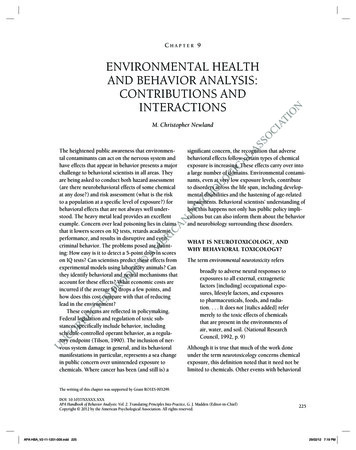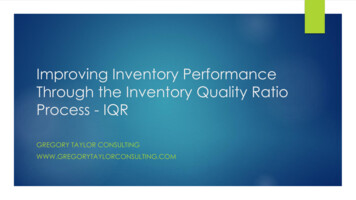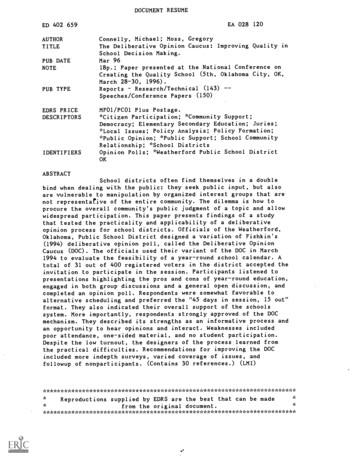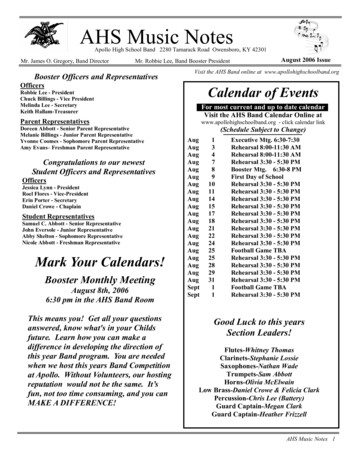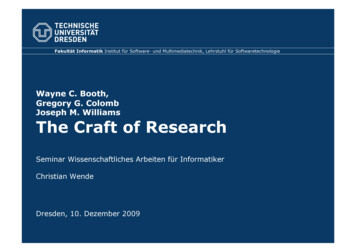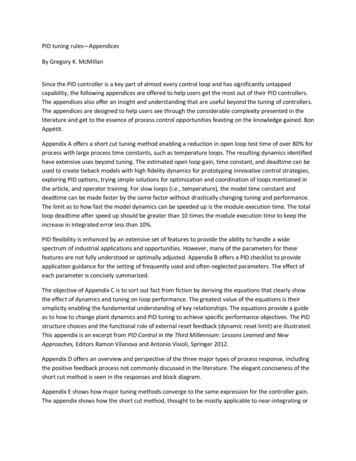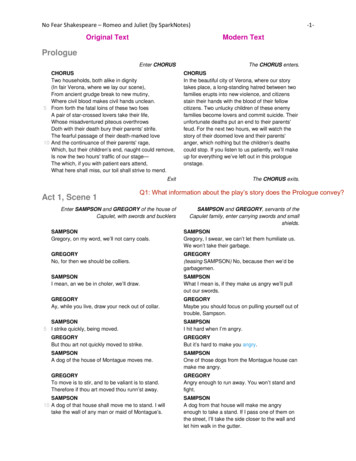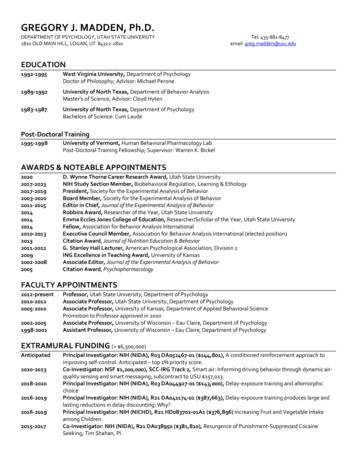
Transcription
GREGORY J. MADDEN, Ph.D.DEPARTMENT OF PSYCHOLOGY, UTAH STATE UNIVERSITY2810 OLD MAIN HILL, LOGAN, UT 84322-2810Tel: 435-881-8477email: greg.madden@usu.eduEDUCATION1992-1995West Virginia University, Department of PsychologyDoctor of Philosophy; Advisor: Michael Perone1989-1992University of North Texas, Department of Behavior AnalysisMaster’s of Science; Advisor: Cloyd Hyten1983-1987University of North Texas, Department of PsychologyBachelors of Science: Cum LaudePost-Doctoral Training1995-1998University of Vermont, Human Behavioral Pharmacology LabPost-Doctoral Training Fellowship; Supervisor: Warren K. BickelAWARDS & NOTEABLE 005D. Wynne Thorne Career Research Award, Utah State UniversityNIH Study Section Member, Biobehavioral Regulation, Learning & EthologyPresident, Society for the Experimental Analysis of BehaviorBoard Member, Society for the Experimental Analysis of BehaviorEditor in Chief, Journal of the Experimental Analysis of BehaviorRobbins Award, Researcher of the Year, Utah State UniversityEmma Eccles Jones College of Education, Researcher/Scholar of the Year, Utah State UniversityFellow, Association for Behavior Analysis InternationalExecutive Council Member, Association for Behavior Analysis International (elected position)Citation Award, Journal of Nutrition Education & BehaviorG. Stanley Hall Lecturer, American Psychological Association, Division 2ING Excellence in Teaching Award, University of KansasAssociate Editor, Journal of the Experimental Analysis of BehaviorCitation Award, PsychopharmacologyFACULTY 51998-2002Professor, Utah State University, Department of PsychologyAssociate Professor, Utah State University, Department of PsychologyAssociate Professor, University of Kansas, Department of Applied Behavioral SciencePromotion to Professor approved in 2010Associate Professor, University of Wisconsin – Eau Claire, Department of PsychologyAssistant Professor, University of Wisconsin – Eau Claire, Department of PsychologyEXTRAMURAL FUNDING ( 16-20192015-2017Principal Investigator: NIH (NIDA), R03 DA052467-01 ( 144,801), A conditioned reinforcement approach toimproving self-control. Anticipated – top 1% priority score.Co-Investigator: NSF 1,200,000), SCC-IRG Track 2, Smart air: Informing driving behavior through dynamic airquality sensing and smart messaging; subcontract to USU 157,013.Principal Investigator: NIH (NIDA), R03 DA044927-01 ( 143,000), Delay-exposure training and allomorphicchoicePrincipal Investigator: NIH (NIDA), R21 DA042174-01 ( 387,663), Delay-exposure training produces large andlasting reductions in delay discounting: Why?Principal Investigator: NIH (NICHD), R21 HD083702-01A1 ( 376,896) Increasing Fruit and Vegetable Intakeamong Children.Co-Investigator: NIH (NIDA), R21 DA038950 ( 381,810), Resurgence of Punishment-Suppressed CocaineSeeking; Tim Shahan, PI.
Curriculum Vitae, Gregory J. Madden, Ph.D.Page -20132007-20112003-20052000-2002Co-Investigator: NIH (NIDA), R21 DA037725 ( 347,000), Theory of Resurgence and Cocaine Seeking; TimShahan, PI.Co-Investigator: NIH (NIDA), 1RO1 DA029100 ( 1,400,000), Understanding Delay Discounting in CigaretteSmokers; Amy Odum, PI.Principal Investigator: NIH (NIDA) 1RO1 DA029605 ( 966,339), Experimental Manipulations of Impulsivity:Effects on Gambling and Drug Taking.Principal Investigator: USDA, Supplement to 59-5000-1-0033 ( 120,000), Increasing the practicality of the FoodDudes healthy eating program.Principal Investigator: USDA, 59-5000-1-0033 ( 155,399), Long-term Effects of Incentivizing Fruit andVegetable Consumption.Principal Investigator: USDA, 59-5000-0-0065 ( 350,000), Incentivizing Fruit and Vegetable Consumption.Principal Investigator: NIH (NIDA) R21 DA023564-01A1 ( 393,000), Impulsivity, Dopamine, and the BehavioralEconomics of Gambling.Principal Investigator: NIH (NIDA) R15 DA016569-01 ( 133,940), Behavioral Economics of Closed Economies.Principal Investigator: NIH (NIDA) R03 DA13575-01 ( 63,669), Impulsivity: Discounting the Benefits of DrugAbstinenceGrant Consulting2016-20182012-2015NSF grant ( 465,892) awarded to Jacob Freeman, Jacopo Baggio (Utah State University) and Thomas Coyle (UTSan Antonio).NIH grant ( 676,424) awarded to Ginger Lockhart & Christian Geiser (Utah State University).Recent Proposals202020212021DHHS Discovery Award, The economics of extinction. ConsultantNIH COBRE grant, Center on Behavioral and Psychosocial Health; University of Kansas. ConsultantNSF, Smart Water: Enhancing surface water sustainability and protecting human health through smart sensingand the internet of things. PI: Ramesh Goel; University of Utah. USU Subcontract.EDITED BOOKS2010201320131 Reviews: 2 Reviews: Madden, G. J., & Bickel, W.K. (Eds., 2010) 1. Impulsivity: TheBehavioral and Neurological Science of Discounting. Washington,D.C.: American Psychological Association (453 pp).Madden, G. J. (Ed.-in-Chief), Dube, W. V., Hackenberg, T., Hanley,G. P., & Lattal, K. A. (Assoc. Eds). (2013) 2. APA handbooks inpsychology: APA Handbook of behavior analysis, Volume. 1: Methodsand principles. Washington, DC: American PsychologicalAssociation.Madden, G. J. (Ed.-in-Chief), Dube, W. V., Hackenberg, T., Hanley,G. P., & Lattal, K. A. (Assoc. Eds). (2013). APA handbooks in psychology: APA Handbook of behavior analysis,Volume. 2: Translating principles into practice. Washington, DC: American Psychological Association.Perma, R. B. (2010). Impulsivity, shortsighted decisions, and discounting. PsycCRITIQUES, 55, Article 1.Weatherly, J. N., & Dixon, M. R. (2011). The why behind the smaller-sooner. The Psychological Record, 61, 633-644.Kazdin, A. E. (2013). Behavior Analysis: Remarkable progress in basic and applied research in understanding and altering complex behavior. PsycCRITIQUES.
Curriculum Vitae, Gregory J. Madden, Ph.D.Page 3TEXTBOOKMadden, G.J., Reed, D. D., & DiGennaro-Reed, F. D. (2021). An Introduction to Behavior Analysis.First edition. Chichester, England: Wiley.PEER-REVIEWED PUBLICATIONSResearch Impact Metrics(http://scholar.google.com/citations?user 0cU0aLUAAAAJ&hl en)h-index 44 (Number of articles receiving h or more citations)h-index since 2016 31Total Citations: 9,700 ( 3,900 since 2016); Most citations for a single article: 1,500 (2ndmost cited: 1,000); Number of papers cited 100 times: 19* Graduate Student Coauthor1.2.3.4.5.6.7.8.9.** Undergraduate Student CoauthorStein, J. S, & Madden, G. J. (in press). Choice bunding, unpacked: Observed and predicted effects of bundle size onintertemporal choice in an additive model of hyperbolic delay discounting. PLoS ONE.Rauwolf, P. Millard, S., Wong, N., Witt, A., Davies, T. J., Cahill, A., Madden, G. J., Parkinson, J., & Rogers, R. D. (in press). ‘Justnot knowing’ can make life sweeter (and saltier): Reward uncertainty alters the sensory experience and consumption ofpalatable food and drinks. Journal of Experimental Psychology: General.*Morrison, K. L., *Smith, B. M., Ong, C. W., Lee, E. B., Friedel, J. E., Odum, A., Madden, G. J., Ledermann, T., *Rung, J., &Twohig, M. P. (2020). Effects of acceptance and commitment therapy on impulsive decision-making. BehaviorModification, 44 (4), 600-623.*Peck, S., *Rung, J. M., *Hinnennkamp, J. E., & Madden, G. J. (2020). Reducing impulsive choice: VI: Delay-exposure trainingreduces aversion to delay-signaling stimuli. Psychology of Addictive Behaviors, 34(1), 147-155.*Renda, C.R., *Rung, J.M., *Peck, S., & Madden, G. J. (2020). Reducing impulsive choice VII: Effects of duration of delayexposure training. Animal Cognition, 1-11. doi: 10.1007/s10071-020-01412-0*Cole, D., *Rung, J. M., & Madden, G. J. (2019). Assessing susceptibility of a temporal discounting task to faking. Journal ofClinical Psychology, 75, 1959-1974. doi: 10.1002/jclp.22831*Joyner, D., Wengreen, H., Aguilar, S., & Madden, G. J. (2019). Effects of the FIT Game on physical activity of sixth graders: Apilot reversal design intervention study. JMIR Serious Games, 7, e13051. doi: 10.2196/13051*Rung, J. M., *Peck, S., *Hinnenkamp, J., *Preston, E., & Madden, G. J. (2019). Changing delay discounting and impulsivechoice: Implications for addictions, prevention, and human health. Perspectives on Behavioral Science, 3, 397-417.*Rung, J. M. & Madden, G. J. (2019). Demand characteristics in episodic future thinking II: Mechanisms of change in delaydiscounting. Experimental and Clinical Psychopharmacology, 27, 482-495.10. *Renda, C.R., *Rung, J.M., *Hinnenkamp, J. E., **Lenzini, S.L., & Madden, G. J. (2018). Impulsive choice and pre-exposure todelays IV: Effects of delay- and immediacy-exposure training relative to maturational changes in impulsivity. Journal of theExperimental Analysis of Behavior, 109, 587-599.11. *Rung, J. M., **Argyle, T. M., **Siri, J., & Madden, G. J. (2018). Choosing the right delay-discounting task: Completion timesand rates of nonsystematic data. Behavioural Processes, 151, 119-125.12. *Rung, J. M., Johnson, P. S., & Madden, G. J. (2018). Differential relations between delay discounting and distress tolerance asa function of opportunity cost and alcohol use. Experimental and Clinical Psychopharmacology, 26, 278-289.13. *Rung, J. M., & Madden, G. J. (2018). Demand characteristics in episodic future thinking: Delay discounting and healthy eating.Experimental and Clinical Psychopharmacology, 26(1), 77-84.14. *Rung, J. M., & Madden, G. J. (2018). Experimental reductions of delay discounting and impulsive choice: A systematic reviewand meta-analysis. Journal of Experimental Psychology: General, 147, 1349-1381.15. *Rung, J. M., Buhusi, C. V., & Madden, G. J. (2018). Reducing impulsive choice V: The role of interval timing. BehaviouralProcesses, 157, 557-561.
Curriculum Vitae, Gregory J. Madden, Ph.D.Page 416. *Joyner, D., Wengreen, H.J., Aguilar, S., Anderson Spruance, L., *Morrill, B. A., & Madden, G. J. (2017). The FIT Game III:Reducing the operating expenses of a game-based approach to increasing healthy eating in elementary schools. Games forHealth Journal: Research, Development, and Clinical Applications, 6, 111-118.17. *Hinnenkamp, J., Shahan, T. A., & Madden, G. J. (2017). How suboptimal is suboptimal choice? Journal of the ExperimentalAnalysis of Behavior, 107, 136-150.18. Madden, G. J., Price, J., & *Sosa, F. A. (2017). Behavioral economic approaches to influencing children’s dietary decisionmaking at school. Policy Insights from the Behavioral and Brain Sciences, 4, 41-48.19. *Smith, B.M., Smith, G.S., Shahan, T.A., Madden, G.J., & Twohig, M.P. (2017). Effects of differential rates of alternativereinforcement on resurgence of human behavior. Journal of the Experimental Analysis of Behavior, 107, 191-202.20. Wengreen, H. J., *Nix, E., & Madden, G. J. (2017). The effect of social norms messaging regarding skin carotenoidconcentrations among college students. Appetite, 116, 39-44.21. *Renda, C.R., & Madden, G.J. (2016). Impulsive choice and pre-exposure to delays III: Four-month test-retest outcomes in maleWistar rats. Behavioural Processes, 126, 108-112.22. *Craig, A., *Nall, R., Madden, G. J., & Shahan, T.S. (2016). Higher rate alternative non-drug reinforcement produces fastersuppression of cocaine seeking but more resurgence when removed. Behavioral and Brain Research, 306, 48-51.23. *Morrill, B. A., Madden, G. J., Wengreen, H. J., Fargo, J. & Aguilar, S. S. (2016). A randomized-control trial of the Food Dudesprogram: Tangible rewards are more effective than social rewards for increasing short- and long-term fruit and vegetableconsumption. Journal of the Academy of Nutrition and Dietetics, 116, 618-629.24. *Renda, C. R., *Stein, J. S., & Madden, G. J. (2015). Working-memory training: Effects on delay discounting in male Long Evansrats. Journal of the Experimental Analysis of Behavior, 103, 50-61.25. *Stein, J. S., *Renda, C. R., **Barker, S.M., **Liston, K.J., Shahan, T.A., & Madden, G. J. (2015). Impulsive choice predictsanxiety-like behavior, but not alcohol or sucrose consumption, in male Long-Evans rats. Alcoholism, Clinical andExperimental Research, 39, 932-940.26. *Stein, J. S., *Renda, C. R., *Hinnenkamp, J., & Madden, G. J. (2015). Impulsive choice, alcohol consumption, and pre-exposureto delayed rewards II: Potential mechanisms. Journal of the Experimental Analysis of Behavior, 103, 33-49.27. Aguilar, S. S., Wengreen, H. J., Lefevre, M., Madden, G. J., & Gast, J. (2014). Skin carotenoids: A biomarker of fruit andvegetable intake in children. Journal of the Academy of Nutrition and Dietetics, 114, 1174-1180.28. *Craig, A. R., **Maxfield, A. D., *Stein, J. S., *Renda, C. R., & Madden, G. J. (2014). Do the adjusting- and increasing-delaytasks measure the same construct: Delay discounting? Behavioural Pharmacology, 25, 306-315.29. *Friedel, J. E., *DeHart, W. B., Madden, G. J., & Odum, A. L. (2014). Impulsivity and cigarette smoking: Discounting ofmonetary and consumable outcomes in current and never smokers. Psychopharmacology (Berlin), 231, 4517-4526.30. *Jones, B. A., Madden, G. J., & Wengreen, H. J. (2014). The FIT Game: Preliminary evaluation of a gamification approach toincreasing fruit and vegetable consumption in school. Preventive Medicine, 68, 76-79.31. *Jones, B. A., Madden, G. J., Wengreen, H. J., Aguilar, S. S., & Desjardins, E. A. (2014). Gamification of dietary decision-makingin an elementary school cafeteria. PLoS ONE, 9(4), e93872. doi:10.1371/journal.pone.009387232. *Morrison, K. L., Madden, G. J., Odum, A. L., *Friedel, J. E., & Twohig, M. P. (2014). Altering impulsive decision making with anacceptance-based procedure. Behavior Therapy, 45, 630-639.33. *Renda, C. R., *Stein, J. S., & Madden, G. J. (2014). Impulsive choice predicts poor working memory in male rats. PLoS ONE,9(4), e93263. doi: 10.1371/journal.pone.009326334. *Johnson, P. S., *Stein, J. S., *Smits, R. R., & Madden, G. J. (2013). Pramipexole-induced disruption of behavioral processesfundamental to intertemporal choice. Journal of the Experimental Analysis of Behavior, 99, 290-317.35. *Smits, R. R., *Stein, J. S., *Johnson, P. S., Odum, A. L., & Madden, G.J. (2013). Test-retest reliability and construct validity ofthe experiential discounting task. Experimental and Clinical Psychopharmacology, 21, 155-163.36. *Stein, J. S., *Johnson, P. S., *Smits, R. R., *Renda, R., **Liston, K. J., Shahan, T. S., & Madden, G. J. (2013). Early andprolonged exposure to reward delay: Effects on impulsive choice and alcohol self-administration in male rats. Experimentaland Clinical Psychopharmacology, 21, 172-180.37. *Stein, J. S., *Smits, R. R., *Johnson, P. S., **Liston, K. J., & Madden, G. J. (2013). Effects of reward bundling on male rats’preference for larger-later food rewards. Journal of the Experimental Analysis of Behavior, 99, 150-158.38. Wengreen, H., Madden, G. J., Aquilar, S., *Smits, R. R., & *Jones, B. A. (2013). Incentivizing children’s fruit and vegetableconsumption: Results of a US pilot-study of the Food Dudes program. Journal of Nutrition, Education, & Behavior, 45, 54-59.
Curriculum Vitae, Gregory J. Madden, Ph.D.Page 539. *Johnson, P. S., Madden, G. J., & *Stein, J. S. (2012). Effects of acute pramipexole on male rats’ preference for gambling-likerewards II. Experimental and Clinical Psychopharmacology, 20, 167-172.40. *Stein, J. S., Pinkston, J. W., *Brewer, A. T., *Francisco, M. T., & Madden, G. J. (2012). Delay discounting in Lewis and Fischer344 rats: Implications for the use of an adjusting-amount procedure to detect between-strain differences. Journal of theExperimental Analysis of Behavior, 97, 305-321.41. Madden, G. J., *Francisco, M. T., *Brewer, A. T., & *Stein, J. S. (2011). Delay discounting and gambling. Behavioural Processes,87, 43-49.42. *Johnson, P., Madden, G. J., *Brewer, A. T., Pinkston, J. W., & Fowler, S. C. (2011). Effects of acute pramipexole on preferencefor gambling-like schedules of reinforcement in rats. Psychopharmacology (Berl), 213, 11-18.43. Madden, G. J., *Johnson, P., *Brewer, A., Pinkston, J. W., & Fowler, S. C. (2010). Effects of pramipexole on impulsive choice inmale Wistar rats. Experimental and Clinical Psychopharmacology, 18, 267-276.44. Madden, G. J., & Kalman, D. (2010). Effects of bupropion on simulated demand for cigarettes and the subjective effects ofsmoking. Nicotine and Tobacco Research, 12, 416-422.45. *Francisco, M. T., Madden, G. J., & Borrero, J. B. (2009). Behavioral economics: Principles, procedures, and utility forapplied behavior analysis. The Behavior Analyst Today, 10 (Special Issue on Translational Research), 277-293.46. Madden, G. J., Petry, N. M., & *Johnson, P. (2009). Pathological gamblers discount probabilistic rewards at lower rates thanmatched controls. Experimental & Clinical Psychopharmacology, 17, 283-290.47. Madden, G. J. (2009). Discounting within the gambling context. Analysis of Gambling Behavior, 2, 93-98.48. Roll, J. M., Madden G. J., Rawson, R., & Petry, N. M. (2009). Facilitating the adoption of contingency management for thetreatment of substance use disorders. Behavior Analysis and Practice, 2, 4-14.49. Chase, P. N., Ellenwood, D. W, & Madden, G. J. (2008). A behavior analytic analogue of learning to use synonyms, syntax, andparts of speech. Analysis of Verbal Behavior, 24, 31-54.50. Madden, G J., *Smith, N. G., *Brewer, A. T., Pinkston, J. W., & *Johnson, P. S. (2008). Steady-state assessment of impulsivechoice in Lewis and Fischer 344 rats: Between-session delay manipulations. Journal of the Experimental Analysis ofBehavior, 90, 333-344.51. Pinkston, J. W., Madden, G. J., & Fowler, S. C. (2008). Effects of darkness on apomorphine-induced pecking in pigeons.Behavioral Pharmacology, 19, 347-352.52. Pinkston, J. W., Ratzlaff, K. L., Madden, G. J., & Fowler, S. C. (2008). An inexpensive infrared detector to verify the delivery offood pellets. Journal of the Experimental Analysis of Behavior, 90, 249-255.53. Madden, G. J., **Smethells, J., **Ewan, E. E., & Hursh, S. R. (2007). Tests of behavioral economic assessments of relativereinforcer efficacy: Economic substitutes. Journal of the Experimental Analysis of Behavior, 87, 219-240.54. Madden, G. J., **Smethells, J., **Ewan, E. E., & Hursh, S. R. (2007). Tests of behavioral economic assessments of relativereinforcer efficacy II: Economic complements. Journal of the Experimental Analysis of Behavior, 88, 355-367.55. Madden, G. J., **Ewan, E. E., & **Lagorio, C.H. (2007). Toward an animal model of gambling: Delay discounting and the allureof unpredictable outcomes. Journal of Gambling Studies, 23, 63-83.56. Madden, G. J., & **Hartman, E. C. (2006). A steady-state test of the demand curve analysis of relative reinforcer efficacy.Experimental and Clinical Psychopharmacology.14, 79-86.57. **Slowiak, J., Madden, G. J., & Matthews, R. (2006). The effects of a combined task clarification, goal setting, feedback, andincentive intervention package to improve telephone customer service in a medical clinic environment. Journal ofOrganizational Behavior Management, 25, 15-35.58. **Lagorio, C.H., & Madden, G. J. (2005). Delay discounting of real and hypothetical rewards III: Steady-state assessments,forced-choice trials, and all real rewards. Behavioural Processes, 69, 173-187.59. Madden, G. J., **Dake, J. M., **Mauel, E. C., & **Rowe, R. R. (2005). Labor supply and consumption of food in a closedeconomy under a range of fixed- and random-ratio schedules: Tests of unit price. Journal of the Experimental Analysis ofBehavior, 83, 99-118.60. *Perry, J. L., *Larson, E. B., *German, J. P., Madden, G. J., & Carroll, M. E. (2005). Impulsivity (delay discounting) as a predictorof acquisition of i.v. cocaine self-administration in female rats. Psychopharmacology, 178, 193-201.61. Madden, G. J., **Raiff, B.R., **Lagorio, C. H., **Begotka, A. M., **Mueller, A.M., **Hehli, D. J., & **Wegener, A. A. (2004).Delay discounting of potentially real and hypothetical rewards II: Between- and within-subject comparisons. Experimentaland Clinical Psychopharmacology, 12, 251-261.62. Madden, G. J., Klatt, K. P., Jewett, D. C., & Morse, L. A. (2004). A forgotten resource critical to the future of behavior analysis:Undergraduate psychology majors. The Behavior Analyst, 27, 33-41.63. Madden, G. J., **Begotka, A. M., **Raiff, B. R., & **Kastern L. L. (2003). Delay discounting of real and hypothetical rewards.Experimental and Clinical Psychopharmacology, 11, 139-145.64. Madden, G. J., & Perone, M. (2003). Effects of alternative reinforcement on human behavior: The source does matter. Journalof the Experimental Analysis of Behavior, 79, 193-206.
Curriculum Vitae, Gregory J. Madden, Ph.D.Page 665. **Harris, A. C., & Madden, G. J. (2002). Delay discounting and performance on the prisoner’s dilemma game. The PsychologicalRecord, 52, 429-440.66. Madden, G. J., Peden, B. F., & **Yamaguchi, T. (2002). Human group foraging and the ideal free distribution. Journal of theExperimental Analysis of Behavior, 78, 1-15.67. Odum, A. L., Madden, G. J., & Bickel, W. K. (2002). Discounting of delayed health gains and losses in current, never-, and exsmokers of cigarettes. Nicotine and Tobacco Research, 4, 295-303.68. Madden, G. J., Bickel, W. K., & Jacobs, E. A. (2000). Three predictions of the economic concept of unit price in a choice context.Journal of the Experimental Analysis of Behavior, 73, 45-64.69. Odum, A. L., Madden, G. J., Badger, G. J., & Bickel, W. K. (2000). Needlesharing in opioid-dependent outpatients:Psychological processes underlying risk. Drug and Alcohol Dependence, 60, 259-266.70. Bickel, W. K., & Madden, G. J. (1999). A comparison of measures of relative reinforcer efficacy and behavioral economics:Cigarettes and money in smokers. Behavioural Pharmacology, 10, 627-637.71. Bickel, W. K., & Madden, G. J. (1999). Similar consumption and responding across single and multiple sources of drug. Journalof the Experimental Analysis of Behavior, 71, 299-316.72. Bickel, W. K., Odum, A., L., & Madden, G. J. (1999). Impulsivity and cigarette smoking: Delay discounting in current, never, andex-smokers. Psychopharmacology, 146, 447-454.73. Madden, G. J., & Bickel, W. K. (1999). Abstinence and price effects on demand for cigarettes: A behavioral-economic analysis.Addiction, 94, 577-588.74. Madden, G. J., Bickel, W. K., & Jacobs, E. A. (1999). Discounting of delayed rewards in opioid-dependent outpatients:Exponential or hyperbolic discounting functions? Experimental and Clinical Psychopharmacology, 7, 284-293.75. Madden, G. J., & Perone, M. (1999). Human sensitivity to concurrent schedules of reinforcement: The role of schedulecorrelated stimuli. Journal of the Experimental Analysis of Behavior, 71, 303-318.76. Shahan, T. A., Bickel, W. K., Madden, G. J., & Badger, G. J. (1999). A comparison of the reinforcing efficacy of nicotinecontaining and de-nicotinized cigarettes. Psychopharmacology, 147, 210-216.77. Bickel, W. K., Madden, G. J., & Petry, N. (1998). The price of change: The behavioral economics of drug dependence. BehaviorTherapy, 29, 545-565.78. Bickel, W. K., & Madden, G. J. (1998). The behavioral economics of smoking. National Bureau of Economic Research WorkingPaper Series: 6444. Cambridge, MA: National Bureau of Economic Research.79. Madden, G. J., Chase, P. N., & Joyce, J. (1998). Making sense of sensitivity in the human-operant literature The BehaviorAnalyst, 21, 1-12.80. Bickel, W. K., Madden, G. J., & DeGrandpre, R. J. (1997). Modeling the effects of combined behavioral and pharmacologicaltreatment on cigarette smoking: Behavioral-economic analyses. Experimental and Clinical Psychopharmacology, 5, 334343.81. Madden, G. J., Petry, N., Badger, G. J., & Bickel, W. K. (1997). Impulsive and self-control choices in opiate-dependent patientsand non-drug-using control participants: Drug and monetary rewards. Experimental and Clinical Psychopharmacology, 5,256-262.82. Mechner, F., Hyten, C., Field, D. P., & Madden, G. J. (1997). Using revealed operants to study the structure and properties ofhuman operant behavior. The Psychological Record, 47, 45-68.83. Glenn, S. S., & Madden, G. J. (1995). Units of interaction, evolution, and replication: Organic and behavioral parallels. TheBehavior Analyst, 18, 237-251.84. Hyten, C., Madden, G. J., & Field, D. P. (1994). Exchange delays and impulsive choice in adult humans. Journal of theExperimental Analysis of Behavior, 62, 225-233.85. Hyten, C., & Madden, G. J. (1993). The scallop in human fixed-interval research: A review of problems with data description.The Psychological Record, 43, 471-500.BOOK CHAPTERS* Graduate student co-author1. Madden, G. J., McClure, S., & Bickel, W. K. (2019). Collaborating to move laboratory findings into public health domains:Maxims for translational research. Chapter 7 in K. L. Hall, A. L. Vogel, & R. T. Croyle (Eds.). Strategies for team sciencesuccess: Handbook of evidence-based principles for cross disciplinary science and practical lessons learned from healthresearchers. Springer (pp. 103-112).2. Madden, G. J., Price, J., & Wengreen, H. (2018). Change and maintaining change in school cafeterias: Economic and behavioraleconomic approaches to increasing fruit and vegetable consumption. Proceedings of the Nebraska Symposium onMotivation, Vol. 45. (pp. 101-125). NY: Springer Nature.
Curriculum Vitae, Gregory J. Madden, Ph.D.Page 73.Madden, G. J., Hanley, G. P., & Dougher, M. J. (2016). Clinical behavior analysis. In J. C. Norcross, G. R. VandenBos, & D. K.Freedheim (Eds.), APA Handbook of Clinical Psychology, Volume 1. Roots and Branches. (pp. 351-368). Washington DC:American Psychological Association.4. *Stein, J.S., & Madden, G.J., & (2013). Delay discounting and drug abuse: Empirical, conceptual, and methodologicalconsiderations. In H. de Wit & J. MacKillop (Eds.), The Wiley-Blackwell Handbook of Addiction Psychopharmacology. Boston,MA: Wiley-Blackwell (pp. 165-208).5. Hursh, S.R., Madden, G.J., Spiga, R., DeLeon, I., & *Francisco, M.T. (2013). The translational utility of behavioral economics:The experimental analysis of consumption and choice. In Madden, G. J. (Editor-in-Chief), Dube, W. V., Hanley, G. P.(Associate Editors). APA Handbook of Behavior Analysis: Volume 2. (pp. 191-224). Washington, DC: American PsychologicalAssociation.6. Neef, N. A., Perrin, C. J., & Madden, G.J. (2013). Understanding and Treating ADHD. In Madden, G. J. (Editor-in-Chief), Dube,W. V., Hanley, G. P. (Associate Editors). APA Handbook of Behavior Analysis: Volume 2. (pp. 387-404). Washington, DC:American Psychological Association.7. Madden, G. J. & *Johnson, P. S. (2010). A discounting primer. In G. J., Madden, & W. K., Bickel (Eds.), Impulsivity: TheBehavioral and Neurological Science of Discounting. (pp. 11-37). Washington, DC: American Psychological Association.8. Petry, N. M., & Madden, G. J. (2010). Discounting and pathological gambling. In G. J., Madden, & W. K., Bickel (Eds.),Impulsivity: The Behavioral and Neurological Science of Discounting. (pp. 273-294). Washington, DC: American PsychologicalAssociation.9. Critchfield, T., & Madden, G. J. (2006). At the crossroads of time and action: A temporal discounting primer for prospectivememory researchers. In. J. Glickson & M.S. Myslobodsky (Eds.), Timing the Future: The Case for a Time-Based ProspectiveMemory (pp. 117-142). Hackensack, NJ: World Scientific.10. Madden, G. J. (2000). A behavioral-economics primer. In. W. K. Bickel & R. Vuchinich (Eds.), Reframing Health Behavior Changewith Behavioral Economics (pp. 3-26). Mahwah, NJ: Lawrence Erlbaum & Associates.11. Bickel, W. K., & Madden, G. J. (1999). The behavioral economics of smoking. In F. J. Chaloupka, M. Grossman, W. K. Bickel, &H. Saffer (Eds.), The Economic Analysis of Substance Use and Abuse: An Integration of Econometric and Behavioral EconomicResearch (pp. 31-61). Chicago, IL: University of Chicago Press.NON-PEER REVIEWED PAPERS1.2.3.4.5.6.7.8.9.10.11.12.13.Bickel, W. K., MacKillop, J., Madden, G. J., Odum, A. L., Yi, R. (2015). Experimental manipulations of delay discounting: Anintroduction to the special issue. Journal of the Experimental Analysis of Behavior, 103, 1-9.Dougher, M. J., Twohig, M., & Madden, G. J. (2014). Editorial: Basic and translational research in stimulus-stimulus relations.Journal of the Experimental Analysis of Behavior, 101, 1-9.Madden, G. J. (2013). At 100 volumes of JEAB, a brief discussion of change and the road ahead. Journal of the ExperimentalAnalysis of Behavior, 100, 1-3.Madden, G, J. (2013). Go forth and be variable. The Behavior Analyst, 36, 137-143.Madden, G. J. (2013). Editorial: An anniversary and an inaugural issue. Journal of the Experimental Analysis of Behavior, 99, 125128.Madden, G. J. (2012). Editorial: Lessons from JEAB to JEAB. Journal of the Experimental Analysis of Behavior, 97, 1-4.Madden, G. J. (2008). Ammunition for fighting a demand-side war on drugs: A review of Contingency Management inSubstance Abuse Treatment. Journal of Applied Behavior Analysis, 41, 645-651.Petry, N.M., Madden, G.J., & Roll, J.M. (2007). The alloplastic nature of pathological gambling: Commentary on Dixon andWeatherly (2007). Analysis of Gambling Behavior, 1, 25-26.Madden, G. J. (2001). Old concerns revisited. Behavioral and Brain Sciences, 24, 543-544.Madden, G. J. (2001). Drug-intake regulation and the interplay between economic costs and benefits. Experimental and ClinicalPsychopharmacology, 9, 148-150.Madden, G. J. (2001). The behavioral economics of drug abuse. International Psychology Reporter, 5, 9-11.Madden, G. J. (1999). A scholarly summary of the animal-learning literature. A review of The Principles of Learning andBehavior. 4th ed. Contemporary Psychology, 44, 156-157.Madden, G. J. (1998). The experimental analysis of consumptio
Association for Behavior Analysis International . 2010-2013 Executive Council Member, Association for Behavior Analysis International (elected position) 2013 Citation Award, Journal of Nutrition Education & Behavior . 2011-2012 G. Stanley Hall Lecturer, American Psychological Association

